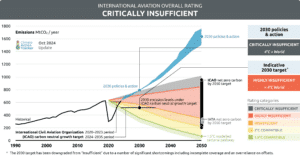Stockholm (NordSIP) – The aviation industry faces accusations of marking its own homework on climate issues as the level of lobbying at the UN-sponsored Committee on Aviation Environmental Protection (CAEP) becomes clear. The committee is a working group set up under the auspices of the United Nations’ International Civil Aviation Organisation (ICAO).
The CAEP’s latest triennial meeting began on 17 February 2025, with corporate lobbying tracking non-profit InfluenceMap issuing the following warning: “Our research finds that opaque proceedings and disproportionate industry presence at ICAO’s previous climate meetings has allowed vested interests to influence the development of climate policies for international aviation without public scrutiny.” According to InfluenceMap, the industry’s flagship Carbon Offsetting and Reduction Scheme for International Aviation (CORSIA) represents a 4-degree warming pathway at best.
The ICAO has a declared long term ‘aspirational’ goal of net zero carbon emissions by 2050. However, the aviation industry’s interim 2030 policies and action are rated ‘Critically Insufficient’ by independent scientific analysis project Climate Action Tracker.

Source: climateactiontracker.org
According to InfluenceMap analysis reported in the UK’s Guardian newspaper, aviation industry representatives outnumbered environmental delegates by a ration of 10 to one at previous CAEP meetings. This mirrors the growing problem of industry lobbying at UN-sponsored climate, biodiversity, and plastic pollution negotiations, but according to InfluenceMap is compounded by the lack of transparency at the aviation-focused events. The general public and the media are typically excluded from CAEP meetings, and supporting material are often either unavailable or hidden behind a paywall.
Analysis of delegates attending the previous CAEP event in 2022 uncovered a meagre 11 delegates from environmental organisations out of a total of 439 attendees, which according to InfluenceMap largely comprised members of aviation industry associations as well as representatives from sponsor organisations. The latter are typically fossil fuel producers like Saudi Aramco, ADNOC, or ExxonMobil, national airline companies, or airplane manufacturers.
The aviation industry’s carbon reduction plans involve the increased use of sustainable aviation fuel (SAF), operation efficiencies, CO2 reductions, and offsetting measures. These are deemed insufficient by Climate Action Tracker, which highlights the aviation industry’s non-CO2 greenhouse gas (GHG) emissions and ambiguity over carbon offsetting schemes as particular weak points. The NGO would like to see these issues addressed as part of the current process of updating nationally determined contributions (NDCs), as well as more ambition on SAF use, greater detail on energy efficiency measures and the electrification of small aircraft.
With 1% of the global population responsible for half of all aviation emissions, the key to reducing the sector’s carbon footprint in line with the goals of the Paris climate agreement may ultimately depend on measures to reduce demand for air travel.




